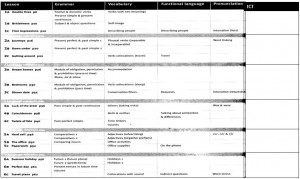One of the biggest challenges facing EFL (and other) teachers today is how to integrate technology into our classes in a meaningful and principled way. If that sounds like you or your trainee teachers, here’s a 1-minute roadmap.
1 Survey the terrain
You can’t start using technology and tools until you know what’s available. You need to survey the terrain. That is, take a good look at what’s out there, get an overview of the tools and software, and think about what each might be good for (or not so good for) in class. Sounds simple, but how do you get up to speed with what’s already there, and how do you keep up with the new tools and software constantly appearing? Some suggestions:
- Follow a couple of key blogs that review tools that teachers can use. My personal favourites: Make use of, Free Technology for teachers, Cool tools for schools, and Nik Peachey’s Learning Technology blog.
- Join online teacher groups that discuss and share information about technology in teaching. My personal favourites: Webheads, and IATEFL Learning Technologies SIG discussion list.
- Build up your PLN (Personal Learning Network) in Twitter, Facebook and/or Google +. Your PLN will share resources and ideas that can help you keep an eye on what’s useful for teaching.
- Keep any eye on websites with regularly updated quality content showcasing new tech tools for teaching. My personal favourites: Our (The Consultants-E) very own Tool of the month, and Russell Stannard’s Teacher Training videos site with tutorials on how to use a wealth of tools.
2 Get a Map
Clearly knowing what’s out there is just the first step. More important is knowing how to map the technology onto your curriculum, so that using tech is not just an ad hoc business of trying stuff out now and again with no particular goal or rationale behind it.
Take your coursebook syllabus (or whatever syllabus you use), and physically map the tasks and tools you could use, onto it, in a grid. Like this:
Brainstorm a number of options and ideas with a group of colleagues for each unit of your coursebook or syllabus. When you’ve got several (3-4) options for each unit, take the next step below to help you decide which to try out and which to discard.
3 Ask for directions
Integrating technology is not just finding a great new tool or idea and then trying it out. You need to be absolutely clear about why you’re using the tool, and what added value it’s bringing to the class. Ask yourself. I’ve blogged about the key questions teachers need to ask themselves here, but in the spirit of a 1-minute guide, here’s a quick summary. Ask yourself about: the outcomes of using the technology, the added value it brings (if any), the time & effort needed to use the tool, the syllabus fit, the skills needed (by teachers and students), location (where you will carry out the activity), and role of the technology (consumption and/or production of digital artefacts?).
4 Test drive
Try out your activities and ideas with a class. Keep notes of how you think it went, what you could do to improve the lesson, and also get feedback from your students. You may think an activity was useful, but your students may think it was a waste of time. So test drive your ideas, and then check.
What about you? What are some of the key principles behind your own use of technology with students? What particular tools work well, and why do you use them? What do you avoid using or doing with students?
Nicky Hockly
The Consultants-E
February 2012


